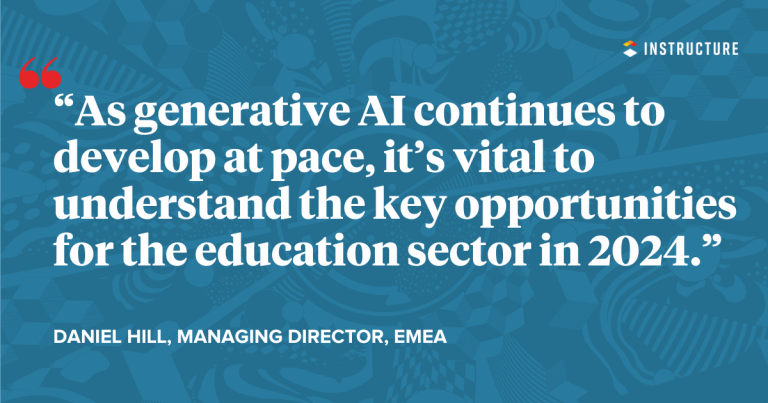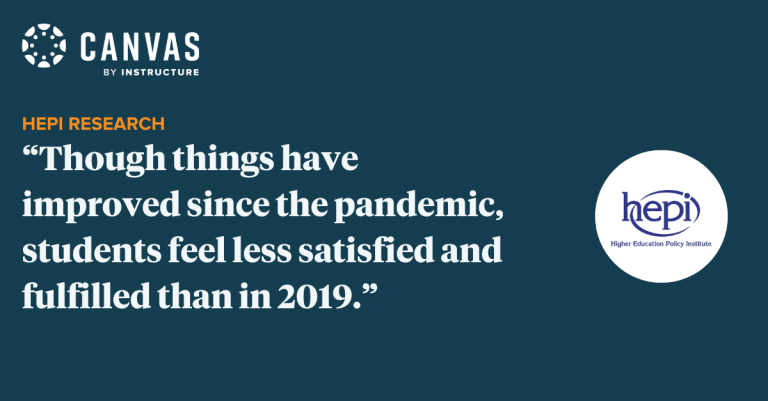
This article was originally published by Education Today.
Generative AI and its impact on education dominated the conversation in 2023 around the world. Starting with an immediate hyper-focus on the fear that students would use generative AI tools to cheat, and that teachers may be replaced, institutions began to work on faculty training and guidelines.
It’s important to acknowledge that generative AI isn’t a passing fad, its direct impact on education will keep evolving. For educators, institutions, and edtech providers, this means finding ways to use AI responsibly and ethically, and to educate teachers and students in order to drive positive student learning and outcomes.
In the UK, according to a recent Hanover Research study commissioned by Instructure, 31% of higher education institutions provide strict guidelines on how to use AI, 36% provide light guidelines, and 66% of respondents are still concerned about cheating and plagiarism.
So, how can AI be a force for good with today’s students? And what impact can it have in bettering the education sector?
Personalised learning for every student
As the education field moves from fear to embracing generative AI as a transformative tool in shaping educational content and experiences, teachers and students will increasingly benefit from AI-generated resources supporting personalised learning, fostering a more engaging and effective learning environment, and saving educators time.
One of generative AI’s biggest benefits is its ability to provide students with faster, more timely feedback. From remedial to advanced feedback, tools can act as a support network for students; via intelligent tutoring and instant feedback – alleviating pressures on students and teachers. These benefits hinge on generative AI’s ability to facilitate personalised learning.
Tailoring programmes – powered by real insights and analysis of student learning practices – to find methods or tools which work best for individuals is another example of the personalised opportunities AI can provide educators and learners alike.
Not only does this create an accessible platform for students, but it also provides a foundation for educators to help those they teach better retain and understand information.
Improving the work-life balance for educators with efficiency
A shortage of teachers is a challenge felt acutely in the UK - as well as internationally. It’s crucial, therefore, educators feel empowered and well-equipped to confidently face the daunting task of educating a growing population.
AI is not the complete answer to understaffed or time-strapped teachers, but it can help to positively influence work-life balance with scalable, intuitive solutions.
For example, reducing administrative burdens by tackling repetitive, daily tasks so educators have more time to focus on what they do best: teach.
This could come in the form of providing remedial feedback at scale, freeing up time for educators to provide more personalised, higher-value assessment and supervision. Alternatively, AI can be used to arm educators with data-driven insights, allowing for optimised learning activities, bespoke learning experiences, and more time to focus on things like student success in the classroom.
An example of how generative AI could serve teachers and students is the combination of the virtual learning environment, Canvas, and the student tutor and teacher assistant, Khanmigo, to save educators time with AI-powered lesson planning, automated grading tools, and AI guidance to help improve student writing outcomes.
What could 2024 have in store for AI & education?
Today, educational institutions share concerns around the impact of AI – namely, student security, privacy, and the protection of institutional IP – in a world of nefarious actors.
According to the Government’s Cyber Security Breaches Survey, 60% of higher education institutions that identified a breach or attack reported losing money or data or had compromised accounts used for illicit purposes.
It’s clear that AI implementation needs to be well thought out, not just for security, but to provide real value to educators and students.
As generative AI continues to develop at pace, it’s vital to understand the key opportunities for the education sector in 2024.
Institutions must prioritise inclusive strategies, ensuring all students have equitable access to educational technology. Implementing Generative AI technologies, for example, can be cost-prohibitive. Exploring ways to manage these costs and ensuring their implementations don’t create a digital divide must be carefully navigated by institutions to avoid increasing educational inequalities.
One such example will be an increase in more affordable price points as edtech providers work to leverage smaller large language models (LLMs) and limit the scope of data transfer to bring costs down.
Additionally, increased global legislation is expected, which will impact the way institutions craft their own policies for AI. One particular example is how AI can and should be used in the classroom to fuel better outcomes with responsible and ethical decision-making.
As AI uptake increases in higher education, we will likely also see an adoption uptick in schools and colleges over time. As development and usage become more widespread, it will continue to present more opportunities to advance learning across entire cohorts.
Related Content
 hepi_blog.png
hepi_blog.pngBlog Articles
 canvas-offline-blog-thumbnail-2024.jpg
canvas-offline-blog-thumbnail-2024.jpgBlog Articles
 img_4584_2.jpg
img_4584_2.jpgBlog Articles
